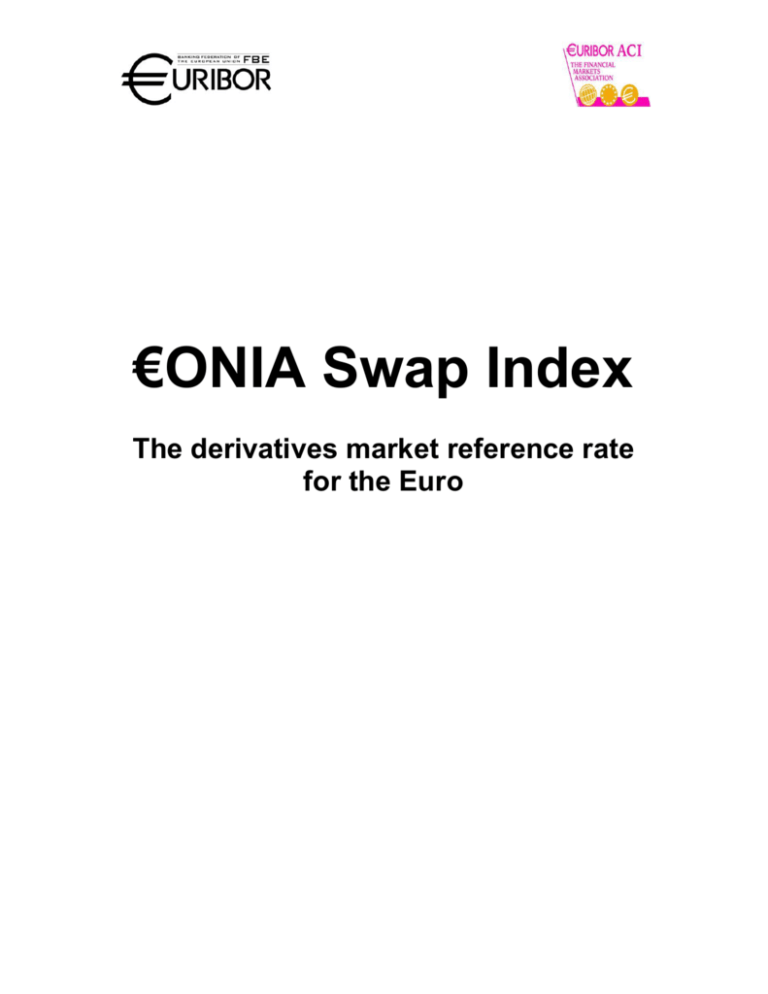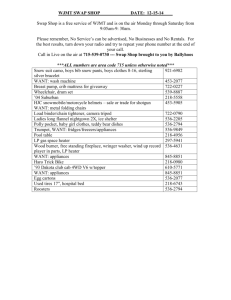
€ONIA Swap Index
The derivatives market reference rate
for the Euro
Contents
Introduction
2
What is an EONIA Swap?
3-4
EONIA Swap Index – The new benchmark
5-8
EONIA FRA
9-10
Basis Swaps
10
IRS vs. EONIA Swap Index
11-14
Advantages of EONIA Swap Index based IRS
14
EONIA Future
15-16
Outlook
16
Disclaimer
17
1
Introduction
With the advent of the Euro, the transformation of numerous national markets into a single currency
market has provided an excellent opportunity for the development of new benchmarks such as the
1
EURIBOR (unsecured) and EUREPO (secured) indices for the money market. This new environment
led to an increasingly homogenous and integrated swap market in the euro area. The growth of the
European swap market over the last seven years has also been accompanied by greater diversity in
the range of actors using interest rate swaps.
The Euro Over-Night Index Average or EONIA swap market was one of the most dramatically affected
sectors within the financial markets. There has been a dynamic growth in the size of the EONIA swap
market in recent years. Tight bid-offer spreads and increasingly high daily volumes have built the basis
for a very liquid product. Electronic trading platforms have created even greater price transparency.
According to the European Central Bank’s regular money market survey, total trading volume has
more than doubled between 2000 and 2007. This sharp increase in volume and the fact that EONIA
Swaps are the most liquid segment of the euro money market reflects the benchmark character the
EONIA swap market plays within the euro money market derivative product range. Therefore
EURIBOR ACI and the European Banking Federation (EBF) decided to introduce a new Index, the
EONIA Swap Index. This new index was established on 20 June 2005, and will further stimulate the
overnight index swap (OIS) swap market, with the development of new products derived from the
EONIA Swap Index currently in progress.
Developments
in O
the
segment
between
2000
and2007
2007
Chart 13 Developments
in the
ISOIS
segment
between
2000
and
250
200
150
100
50
0
2000
2001
Up to 1 Month
2002
2003
2004
1 Month to 3 Months
2005
3 Months to 1 Year
2006
2007
More than 1 Year
Note: The volume of overnight indexed swaps (OIS) in Q2 2002 is taken as the base (100). The panel comprised 85 banks in 2000
and 2001 and 114 banks from 2002 to 2007.
1
Euribor®, EUREPO® and EONIA® are worldwide registered trademarks of Euribor FBE. All rights reserved.
Additional information on these benchmarks can be found on www.euribor.org and www.eurepo.org.
2
What is an EONIA Swap?
An EONIA swap is similar to a plain vanilla interest rate swap transaction i.e. an exchange of a fixed
rate interest cash flow for a variable rate cash flow or vice-versa. In essence, one interest rate is
received, while at the same time the other one is paid. That is, at the time an EONIA swap is
concluded, the parties determine the payer and the receiver of the fixed interest rate, with the variable
interest rate being exchanged in the opposite direction. Upon settlement, only the net cash flows are
paid one business day after maturity. The nominal amount on which the interest payments are
calculated is not exchanged. The diagram below illustrates the structure of an EONIA Swap. For
example, a payer in an EONIA Swap transaction pays a fixed rate and receives a floating rate pegged
to the daily EONIA setting.
The fixed rate, often called the swap rate, and the nominal amount is agreed at the time the contract is
concluded.
For calculating the variable rate the following formula shall be applied.
r
360
n
te 1
1
i ts
ri * di
360
(1)
1
r
ts
Variable rate taking compound interest into account
te
End Date of the EONIA Swap
ri
EONIA fixing rate on the i-th day
di
Number of days that the value ri is applied (normally one day, three days for weekends)
n
Total number of days
Start date of the EONIA swap
3
Example
Two counterparties agree to enter into the following EONIA swap for a nominal of EUR 500 million.
Counterparty A is the receiving party of the swap. A fixed rate of 3.85% is agreed over a term of seven
days. Party B assumes the opposite position, paying the fixed rate and receiving the variable rate. The
EONIA fixes at following (fictitious) levels:
Wednesday
3.82%
Thursday
3.82%
Friday (valid for three days)
3.82%
Monday
3.82%
Tuesday
3.81%
The variable rate could be calculated by using formula (1).
r
360 1 0.0382 / 360 1 0.0382 / 360 1 0.0382 * 3 / 360 1 0.0382 / 360 1 0.0381 / 360
7
1
A calculation of our example results in the following figures: the variable rate of the EONIA swap is
3.8196%. Considering the notional amount of EUR 500 million, party A would normally receive a fixed
rate of EUR 374,305.56 (3.85% * 7/360 * EUR 500 million) and pays a variable rate of EUR
371,350.00 (3.8196% * 7/360 * EUR 500 million). But only the difference between these two figures is
exchanged, so that A receives from B a payment of EUR 2,955.56.
4
0.038196
EONIA Swap Index – The new benchmark
The EONIA Swap Index is the derivative market’s new reference rate for the Euro, as sponsored by
the EBF. It completes the range of existing benchmark indices for the unsecured (EURIBOR) and
secured (EUREPO) cash markets.
The EONIA Swap Index is the mid-market rate at which EONIA swaps, as quoted by a representative
panel of prime banks, which actively provide prices in the EONIA swap market. The index is calculated
2
daily at 11:00 CET and rounded to three decimal places on an actual/360 day count convention. The
range of quoted maturities is 1, 2, and 3 weeks and monthly maturities between one and twelve month.
Longer maturities for 15, 18, 21 and 24 months have been added in May 2007. These are quoted on
act/360 basis with annual payment and the broken period at the beginning. The EONIA Swap Index
reference rates are calculated and published by Reuters based upon the information of the
participating panel banks on page: EONIAINDEX. They are also published on www.eoniaswap.org.
Banks may qualify for the EONIA Swap Index Panel if they meet the following criteria:
They are active players in the Euro derivative markets either in the euro area or worldwide
and have the ability to transact good volumes in EONIA Swaps, even under turbulent market
conditions
Panel banks must have a high credit rating high ethical behaviour and enjoy an excellent
reputation
Panel banks must disclose all relevant information requested by the Steering Committee
The number of panel banks will be sufficient to both represent the diversity of the EONIA swap market
and guarantee an efficient manageable panel consisting of only prime banks. At present, 25 prime
banks constitute the EONIA Swap Index Panel. These selected banks are obliged to quote the EONIA
Swap Index for the complete range of maturities, in a timely manner, every business day with an
accuracy of three decimal places. The EONIA Swap Index can point to a strict Code of Conduct which
sets out the criteria for inclusion of banks in the panel. The Code of Conduct details the obligations
resting on each bank, and outlines the tasks and composition of the Steering Committee which
oversees the Index. This independent Steering Committee, which consists of 10 members, closely
monitors all market developments and ensures, by reviewing panel banks’ contributions on a regular
basis, strict compliance with the Code of Conduct. It has the right to request information, remove or
appoint panel banks.
2
Until March 2008 daily fixings took place at 16:30 CET.
5
Potential uses and benefits of the new EONIA Swap Index are:
New product developments and market enhancements, such as EONIA Swap FRA, EONIA
Index OTC Option
The Index may be used as an independent risk management and valuation tool. It sets the
basis for market conformity checks and allows banks and their clients, for example money
market funds, to run their revaluation against an official reference rate
It serves as a benchmarking tool for the derivative markets, similarly to the EURIBOR and
EUREPO indices at the short end of the European yield curves
The EONIA Swap Index can also be used as a reference rate for longer dated interest rate
swaps. A revival of the pre-euro French TAM (Taux Annuel Monetaire) swap market is
possible. A T4M/TAM Swap was an Interest Rate Swap Transaction where one party pays a
fixed rate and the other one the floating rate. The calculation of the floating leg was based on
the average monthly money market rate for T4M Swaps and on the annual monetary rate for
TAM transactions, which was based on the EONIA rate
Additional flow volumes for the basis swap market are expected. This results from a precise
basis perception of the market participants.
In sum the EONIA Swap Index serves a wide range of Global Market Business. It provides major
opportunities for the participants in the financial markets to increase the professional set-up and
profitability of their business.
All this information can be found on the EBF website: www.eoniaswap.org
6
Here is an overview of the recent spreads of the 2 key European reference rates:
European Reference Rates (1 Month)
4.90
4.70
4.50
4.30
4.10
3.90
31 Jul 07
07 Sep 07
15 Oct 07
22 Nov 07
EONIA Index
30 Dec 07
06 Feb 08
EURIBOR
15 Mar 08
22 Apr 08
30 May 08
EUREPO
Spread to EUREPO (1 Month)
93.0
73.0
53.0
33.0
13.0
-7.0
31 Jul 07
07 Sep 07
15 Oct 07
22 Nov 07
EONIA Index
30 Dec 07
06 Feb 08
EURIBOR
7
15 Mar 08
EUREPO
22 Apr 08
30 May 08
European Reference Rates (3 Months)
4.88
4.68
4.48
4.28
4.08
3.88
31 Jul 07
07 Sep 07
15 Oct 07
22 Nov 07
EONIA Index
30 Dec 07
06 Feb 08
EURIBOR
15 Mar 08
22 Apr 08
30 May 08
EUREPO
Spread to EUREPO (3 Months)
94.0
74.0
54.0
34.0
14.0
-6.0
31 Jul 07
07 Sep 07
15 Oct 07
22 Nov 07
EONIA Index
30 Dec 07
06 Feb 08
EURIBOR
8
15 Mar 08
EUREPO
22 Apr 08
30 May 08
EONIA FRA
EONIA FRAs have already been designed. An EONIA FRA is a trade where two counterparties are
contracting an EONIA Swap rate and notional amount for an agreed period for a future date. Two
business days before the value date of the EONIA Swap the contract will be fixed against the EONIA
Swap Index. The contract will be settled in cash and the settlement amount will be the discounted
value of the difference between the agreed FRA rate and the EONIA Swap Index (reference rate). No
EONIA swap position will result out of the FRA deal.
On the fixing date, the cash settlement amount of the EONIA FRA buyer will be computed as follows:
days * nominal
360
days
1 EONIASwapIndex
360
EONIAFRARa te
SettlementPayment
EONIASwapIndex
(2)
The following example should illustrate the potential use of an EONIA FRA. In this case Party A wants
protection against falling interest rates for incoming cash flows in three months time for three months.
The incoming cash flows are usually invested in the cash market. To solve this problem Party A has to
sell a 3x6 EONIA FRA to lock in interest rates and stay flexible on daily liquidity fluctuations. Following
situation is assumed:
PERIOD
DAYS
RATE
o/n
1
3.820%
1m
31
3.850%
3m
92
3.900%
6m
184
4.010%
Principal: EUR 10.000.000
3x6 Forward Rate: 4.079%
At the fixing date of the EONIA FRA, the agreed EONIA FRA Price is compared to the 3M-EONIA
Swap Index.
Fixing Date = Settlement Date minus 2 business days
92 days
dealing date
3 months
6 months
Settlement Date:
Maturity Date
3M-EONIA Swap Index vs. EONIA
FRA rate difference discounted on
settlement date
9
The table below shows calculated FRA settlement amounts in respect to different 3M-EONIA Swap
Index values. A decrease/increase in the Index results in positive/negative payments on the settlement
date. In the case of decreasing interest rates the effect of lower interest payments on the principal
investment is offset by the positive EONIA FRA payout.
3M-EONIA
3.700%
Swap Index
9,594.83
P/L
3.800%
3.900%
4.000%
4.079%
4.100%
4.200%
4.300%
7,061.43
4,529.30
1,998.46
0.00
-531.10
-3,059.38
-5,586.39
EONIA FRAs keep the operational costs at a minimum. Also the parties avoid unexpected
performance volatility, which could occur if they had to physically enter into an EONIA Swap after
trading a forward EONIA Swap (through reserve ends, tender underbidding etc.)
Basis Swaps
A basis swap is a floating-floating interest rate swap. Basis swaps between two floating indices from
different segments of the money market are quite common. Basis Swaps could limit the risk that a
company faces as a result of having lending or borrowing rates tied to a different reference index.
Assume a bank lends money to a company at a variable rate that is tied to the European Interbank
Offered Rate (EURIBOR) but the short-term liquidity management of the bank is benchmarked against
EONIA rates. By entering into a EURIBOR – EONIA Swap Index Basis Swap the bank eliminates this
kind of risk. The structure of this deal is displayed in the diagram below.
3M-EURIBOR
Loan
Basis
Swap
Bank
Company
3M-EONIA
Swap Index
3M-EURIBOR
+ Spread
Refinancing
EONIA based
MM
10
IRS vs. EONIA Swap Index
It can be imagined that a bank lends money to a company for a period of 12 months and receives a
fixed rate at maturity. In our example, the bank prefers to receive a floating rate, e.g. the 1M-EONIA
Swap Index, and thus enters into a fixed-floating interest rate swap.
Fixed Rate
Loan
Bank
Company
1M-EONIA
Swap Index
Fixed Rate
+ Spread
Interest
Rate
Swap
Example
Suppose we have just received the following EONIA FIXINGS from REUTERS.
What is the fair fixed rate of an IRS, as described above, for the period of 02 April 2008 to 02 April
2009 on a notional of € 1,000,000.00?
11
In a first step, we are creating a table that states the fixings, the exact start and end dates as well as
the corresponding actual days for each period.
Start Date
End Date
Months
Actual
Days
EONIA SWAP
INDEX FIXINGS
02/04/2008
02/05/2008
1
30
3.992%
02/04/2008
02/06/2008
2
61
3.995%
02/04/2008
02/07/2008
3
91
3.994%
02/04/2008
04/08/2008
4
124
3.992%
02/04/2008
02/09/2008
5
153
3.991%
02/04/2008
02/10/2008
6
183
3.976%
02/04/2008
03/11/2008
7
215
3.950%
02/04/2008
02/12/2008
8
244
3.927%
02/04/2008
02/01/2009
9
275
3.901%
02/04/2008
02/02/2009
10
306
3.877%
02/04/2008
02/03/2009
11
334
3.857%
02/04/2008
02/04/2009
12
365
3.838%
Based on these figures, we can now price the actual EONIA FRAs:
Start Date
End Date
Actual
Days
Rate
1M - EONIA Swap Index
02/04/2008
02/05/2008
30
3.992%
1x2 EONIA FRA
02/05/2008
02/06/2008
31
3.985%
2x3 EONIA FRA
02/06/2008
02/07/2008
30
3.965%
3x4 EONIA FRA
02/07/2008
04/08/2008
33
3.947%
4x5 EONIA FRA
04/08/2008
02/09/2008
29
3.933%
5x6 EONIA FRA
02/09/2008
02/10/2008
30
3.834%
6x7 EONIA FRA
02/10/2008
03/11/2008
32
3.726%
7x8 EONIA FRA
03/11/2008
02/12/2008
29
3.670%
8x9 EONIA FRA
02/12/2008
02/01/2009
31
3.601%
9x10 EONIA FRA
02/01/2009
02/02/2009
31
3.558%
10x11 EONIA FRA
02/02/2009
02/03/2009
28
3.522%
11x12 EONIA FRA
02/03/2009
02/04/2009
31
3.508%
12
To make the results and our purpose more graphic, we included them in the chart below.
Fixed Rate (i) = ?
4.10%
4.00%
3.90%
3.80%
3.70%
3.60%
3.50%
3.40%
3.30%
3.20%
1M-EONIA
Swap Index
1*2 EONIA
FRA
2*3 EONIA
FRA
3*4 EONIA
FRA
4*5 EONIA
FRA
5*6 EONIA
FRA
6*7 EONIA
FRA
7*8 EONIA
FRA
8*9 EONIA
FRA
9*10 EONIA 10*11 EONIA 11*12 EONIA
FRA
FRA
FRA
Since we have now calculated all consecutive FRAs, we can fix the cost of borrowing from month to
month (i.e. the floating leg of the IRS) in advance. It is what leads to the fixed costs for the whole
period.
Start Date
End Date
Actual
days
Rate
Discount
Factor
Portfolio at
period begin
Interest
Portfolio at
period end
02/04/2008
02/05/2008
30
3.992%
0.9967
€1,000,000.00
€3326.67
€1,003,326.67
02/05/2008
02/06/2008
31
3.985%
0.9966
€1,003,326.67
€3442.64
€1,006,769.31
02/06/2008
02/07/2008
30
3.965%
0.9967
€1,006,769.31
€3326.64
€1,010,095.94
02/07/2008
04/08/2008
33
3.947%
0.9964
€1,010,095.94
€3654.28
€1,013,750.22
04/08/2008
02/09/2008
29
3.933%
0.9968
€1,013,750.22
€3211.53
€1,016,961.75
02/09/2008
02/10/2008
02/10/2008
03/11/2008
30
32
3.834%
3.726%
0.9968
0.9967
€1,016,961.75
€1,020,211.33
€3249.58
€3378.94
€1,020,211.33
€1,023,590.28
03/11/2008
02/12/2008
29
3.670%
0.9971
€1,023,590.28
€3026.06
€1,026,616.33
02/12/2008
02/01/2009
31
3.601%
0.9969
€1,026,616.33
€3182.97
€1,029,799.31
02/01/2009
02/02/2009
31
3.558%
0.9969
€1,029,799.31
€3155.19
€1,032,954.50
02/02/2009
02/03/2009
28
3.522%
0.9973
€1,032,954.50
€2829.89
€1,035,784.39
02/03/2009
02/04/2009
31
3.508%
0.9970
€1,035,784.39
€3128.67
€1,038,913.06
13
As shown above, it would cost € 38,913.01 (the FV of the portfolio minus the starting notional) to fix
the floating leg for the period of 02 April 2008 to 02 April 2009. The equivalent fixed rate for the whole
period equals the effective “fair” fixed rate (i=3.838%) that the bank has to pay to the IRS counterparty.
Again the advantage of trading a 12month vs 1month EONIA Swap Index IRS is to avoid daily reset
risk on the EONIA (ON) Fixing (through reserve ends, tender underbidding etc.)
Advantages of EONIA Swap Index based IRS
For longer dated Interest Rate Swaps (2-10 years) the EONIA Swap Index can be used as a reference
Rate to create an IRS market based on the new index. EONIA Swap Index based IRS could close the
gap of the liquid pre-euro French T4M/TAM market. They can provide the same economic effect as
T4M/TAM Swaps but without their downsides. In comparison to T4M/TAM transactions there is no
need to compute daily fixings and valuations. Due to its simplicity EONIA Swap Index based IRS are
simpler to administrate and therefore the cheaper alternative.
In terms of documentation and confirmation EONIA Swap Index based IRS are as easy to handle as
EURIBOR Swaps.
14
EONIA Future
An EONIA Swap Index Future is similar to an EONIA FRA but traded on exchanges as a standardised
product instead of Over-the-Counter (OTC) and is marked to market on a daily basis via a Clearing
House.
The specifications of EONIA Swap Index Futures contracts traded on Liffe are shown in the table
below:
Unit of Trading
€1,000,000
Mar, Jun, Sep and Dec, and four serial months such that eight
Delivery Months
delivery months are available for trading with the nearest six
delivery months being consecutive calendar months
Quotation
Minimum Price Movement
Tick Size (Value)
100.00 minus rate of interest
0.005 (€12.50)
Two business days prior to the third Wednesday of the
Last Trading Day
Delivery Month. On the Last Trading Day, trading in the front delivery
month will cease at 10:00 London Time
Delivery Day
Exchange Delivery
Settlement Price (EDSP)
First business day after the Last Trading Day
Is based on the Three Month EONIA Swap Index, as sponsored by
the European Banking Federation (EBF), at 11.00 hours CET on
the Last Trading Day.
To understand how EONIA Swap Index Futures work, consider for example a September 2008 Liffe
Three Month contract:
On September 16, 2008, the settlement price is set equal to 100 minus the Three Month
EONIA Swap Index level on the Last Trading Day, and there is a final cash settlement
reflecting this price. The contract is designed so that a half basis point move in the Futures
quote corresponds to a gain (when being long) or loss (when being short) of €12,50 per
contract. In other words, a Three Month EONIA Swap Index Future contract allows an investor
to lock in an EONIA Swap of €1 million for a future 3-month period starting on the Delivery Day.
€1million * 0,00005 * 0,25
15
€12,50
EONIA Swap Index Futures are useful in many respects:
–
As a Hedging Tool
–
Markets today have a wide and volatile spread between EONIA and Euribor. This
makes EONIA Swap Index Futures attractive to short term money managers (Repo,
Reverse Repo, Money Market Funds, Treasury) and ‘spread’ traders
–
Asset allocation facilities allow inter-contract spread trading with other exchangetraded interest rate contracts like the Euribor Future
–
Margin netting between EONIA Swap Index and Euribor Futures by Liffe
–
Block Trading through wholesale trading facilities.
Outlook
The implementation of the EONIA Swap Index has created the potential for a number of products.
The strong rise in EONIA Swap volumes in 2006 already implies an increasing number of market
users of the underlying product due to higher transparency and the possibility for an official daily
valuation process. This development is likely to continue with the revaluation curve now available up
to 2 years.
At first, a commitment of the major market makers will be formed to start the EONIA FRA product, as
the documentation framework is now in place (ISDA included the EONIA Swap Index in its “2006
Definitions”).
An exchange traded futures contract on the EONIA Swap Index has just started as described above.
Long term IRS markets and basis swaps should follow, once the index and the EONIA FRA and
Futures products get more known by all market participants.
Options on the new index will be next and should offer additional products to position for a changing
rate environment.
So, there is more in the pipeline to come. It’s up to the markets to use the potential the new EONIA
Swap Index is providing. A prosperous future for it is quite likely.
16
Disclaimer for Euribor ACI / EONIA Swap Index brochure
19 June 2008
Liffe is the brand name of the derivatives business of Euronext - a subsidiary of
NYSE Euronext - comprising the Amsterdam, Brussels, Lisbon, London and Paris
derivatives markets. Those wishing either to trade in any products available at Liffe or
to offer and sell them to others should consider both their legal and regulatory
position in the relevant jurisdiction and the risks associated with such products before
doing so. Potential users of Liffe contracts should familiarise themselves with the full
contract specification of the product concerned and any associated information.
NYSE Euronext and its subsidiaries shall not be liable for the use of information
contained herein, and are not responsible for any omissions or errors contained
within this information. Liffe® is a registered mark of NYSE Euronext.
17





